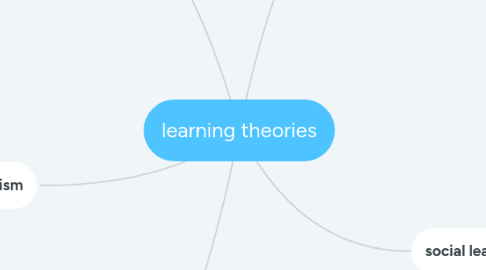learning theories
by alayna chavez

1. cognitivism
1.1. the mind is an information processor - emphasizes understanding the concept as a whole instead of just the pieces
1.2. strong emphasis on mental processes and often with an emphasis on modern technologies
1.3. we can use this in a classroom by starting a lesson with a hook to create interest, a review quiz promotes prior learning, using learning outcomes, chunking content into organized bite size pieces, using graphic organizers and the student takes on an active role in learning
1.4. Bloom’s Taxonomy: 6 major skills and abilities: knowledge, comprehension, application, analysis, synthesis, and evaluation.
2. constructivism
2.1. students learn new things through experience - they build knowledge through experiences and interactions, self directed learning.
2.2. view learning as the result of mental construction - learning takes place when new information is built into and added onto an individual’s current structure of knowledge understanding, and skills.
2.3. we can use this in a classroom by introducing new topics and new ways of learning that they may not have done before
2.4. Piaget: creator of the theory of cognitive development, suggests that intelligence changes as children grow.
3. connectivism
3.1. stresses connections and combinatorial creativity - a learning community is described as a node and a learning network are the nodes coming together to form a mass intelligence.
3.2. like social learning theory, this can be out to use in a classroom in group projects - these help to create connections between peers, relationships, and a community where students feel comfortable sharing.
3.3. especially in the pandemic, we’ve seen new ways connections can occur virtually - like Zoom, other ways of connecting with one another became prevalent in our lives
3.4. Siemens and Downes created this theory
4. behaviorism
4.1. the learner is a passive blank slate shaped by environmental stimuli, both positive and negative reinforcement
4.2. rewards motivate people to do things and repeat them
4.3. one way this can be used in a classroom is repeating information - for example, flashcards. going through the flashcards again and again helps to learn the information.
4.4. one example in technology is quizlet. quizlet is a study tool that utilizes a lot of repetition to help someone study.
4.5. Pavlov’s dogs: Pavlov rings a bell and gives a dog a treat, everytime he rings the bell, the dog’s mouth salivates. Conditions them to repeat this behavior everytime they see the bell
5. social learning theory
5.1. social interaction helps with learning - people are born with 4 elementary mental functions - attention, sensation, perception, and memory.
5.2. a good social and cultural environment allows us to use elementary skills to develop and gain higher mental functions
5.3. a child working with an adult are able to learn more than a child not working with an adult - emphasis is placed upon interaction between the learner and others
5.4. we can integrate this into a classroom by doing group work, assignments that allow stimulation and create connections and offer feedback and the ability to work with a teacher.
5.5. Vgostky: argued that social interaction is crucial for cognitive development.


